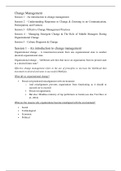Samenvatting
Change Management Summary
- Vak
- Instelling
Samenvatting van het vak Change Management van de Master of Business Administration van de Universiteit van Amsterdam (UvA). De samenvatting bevat alle slides van de lessen, de belangrijkste punten uit de artikelen, en een aantal beantwoorde discussievragen.
[Meer zien]



